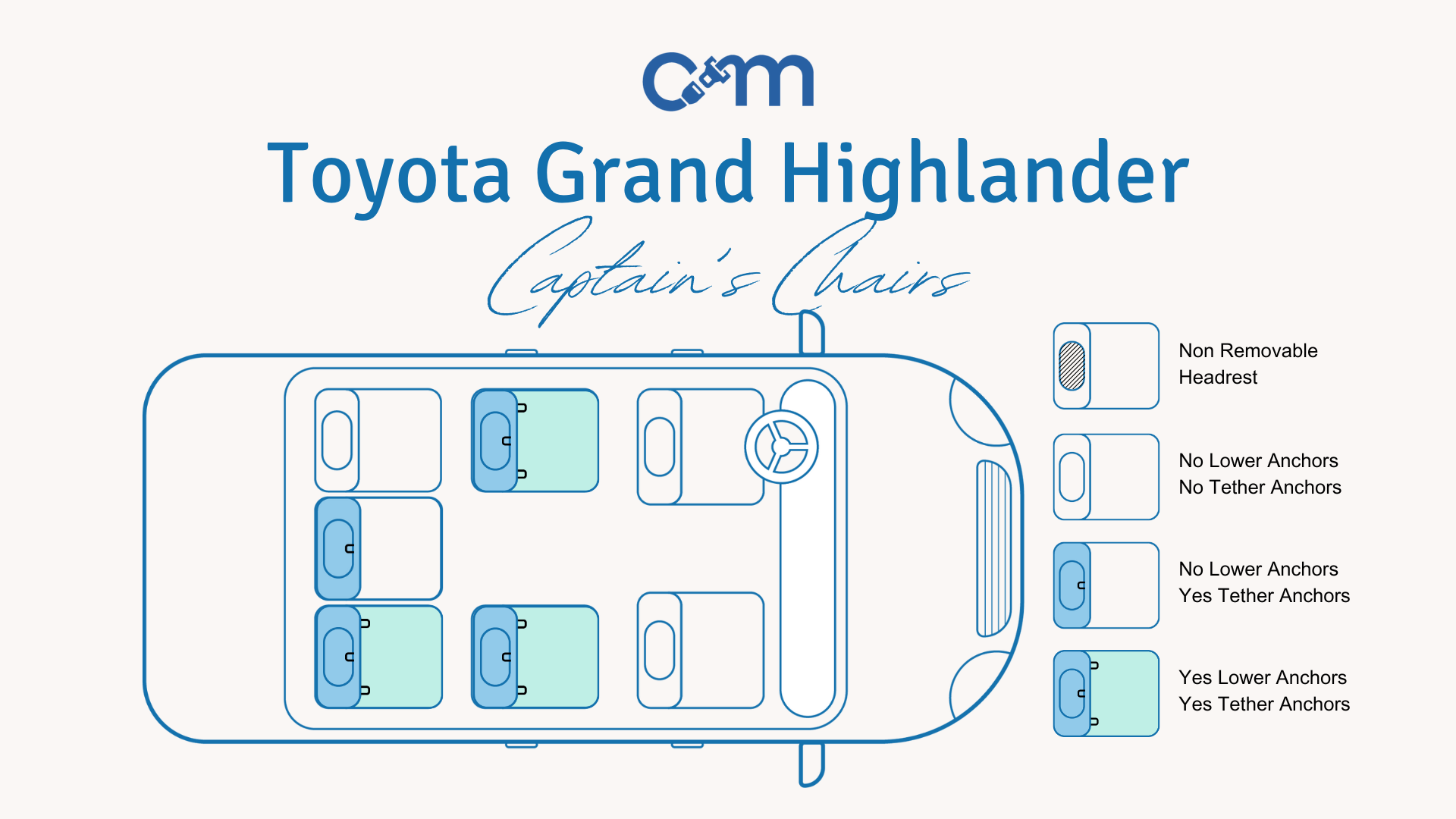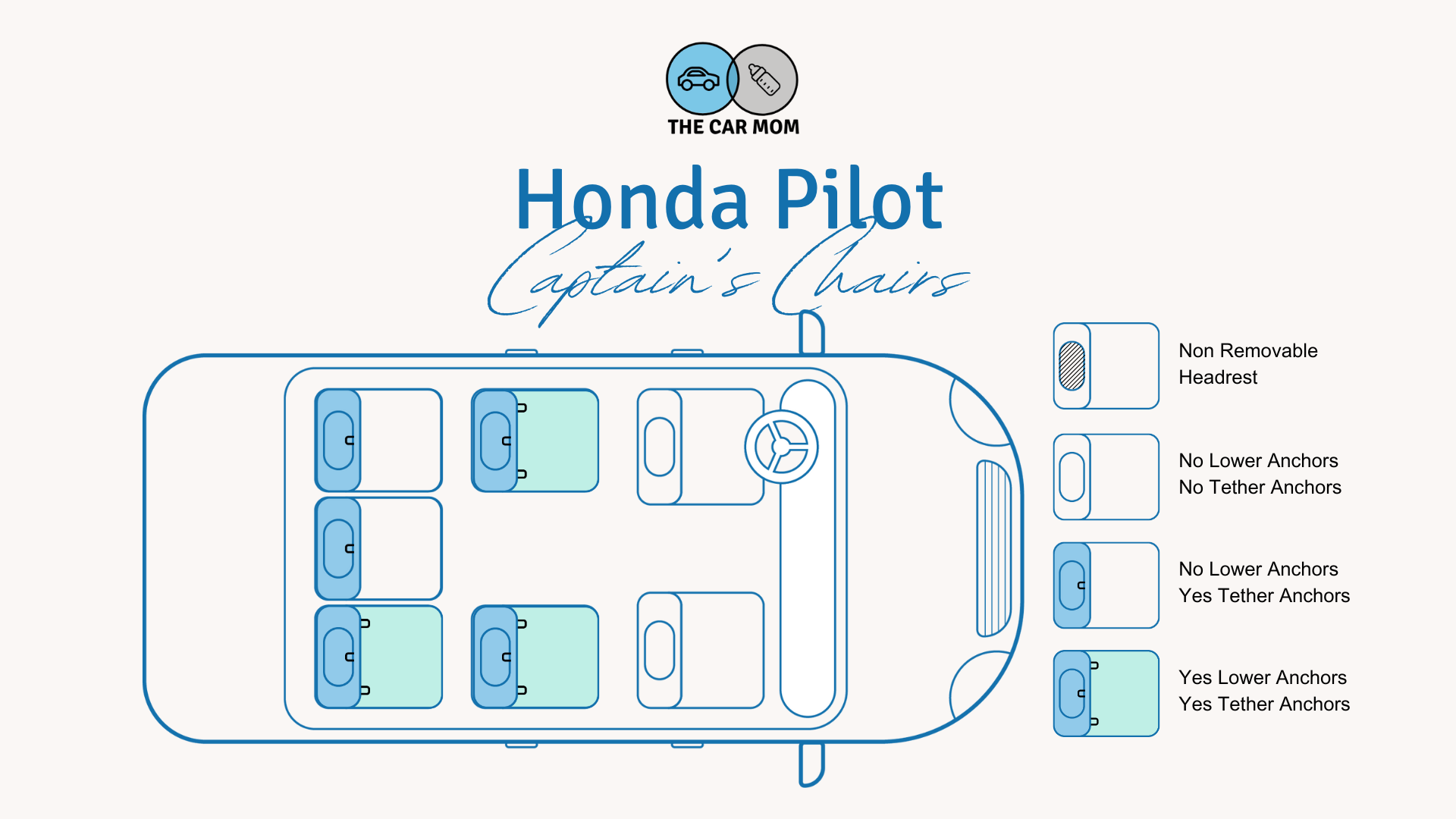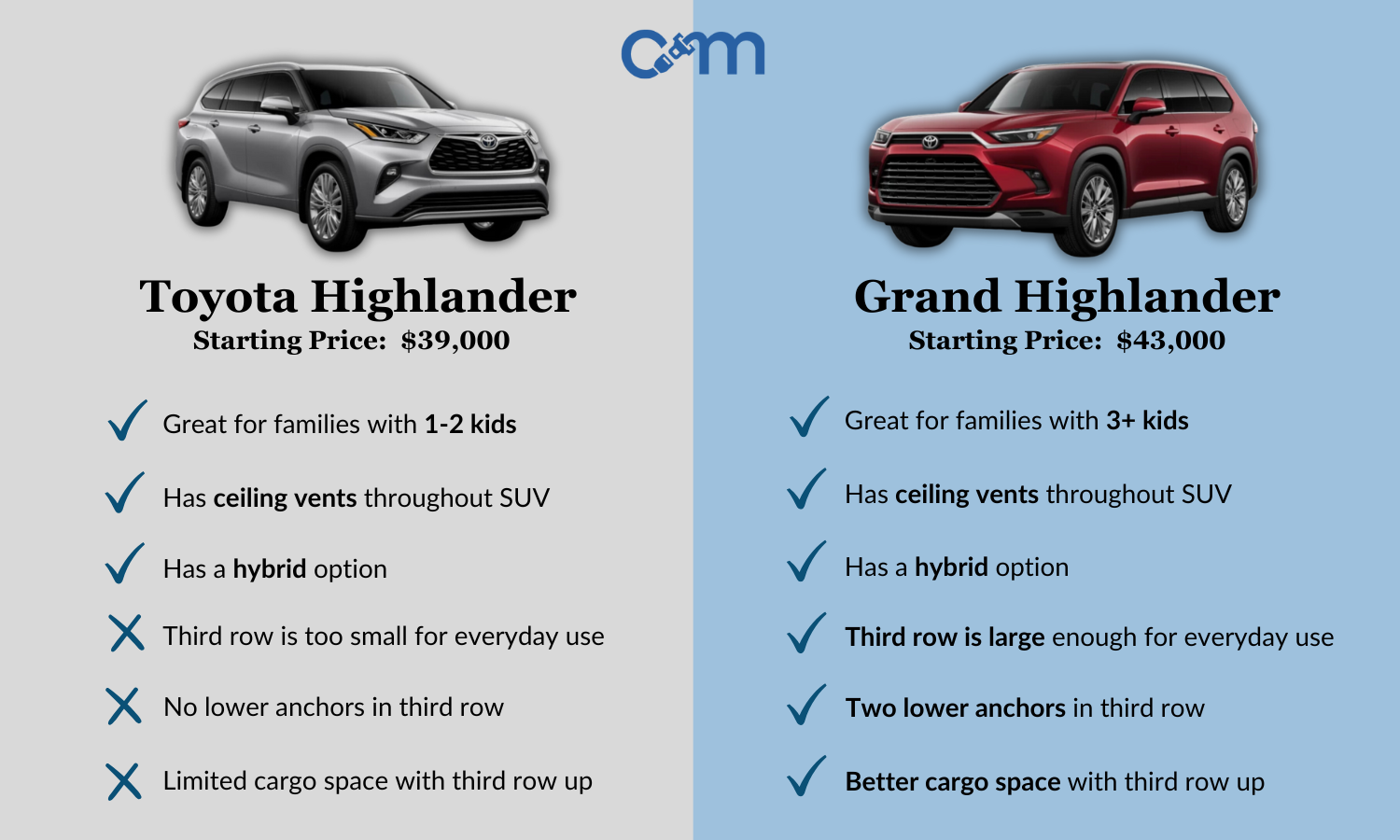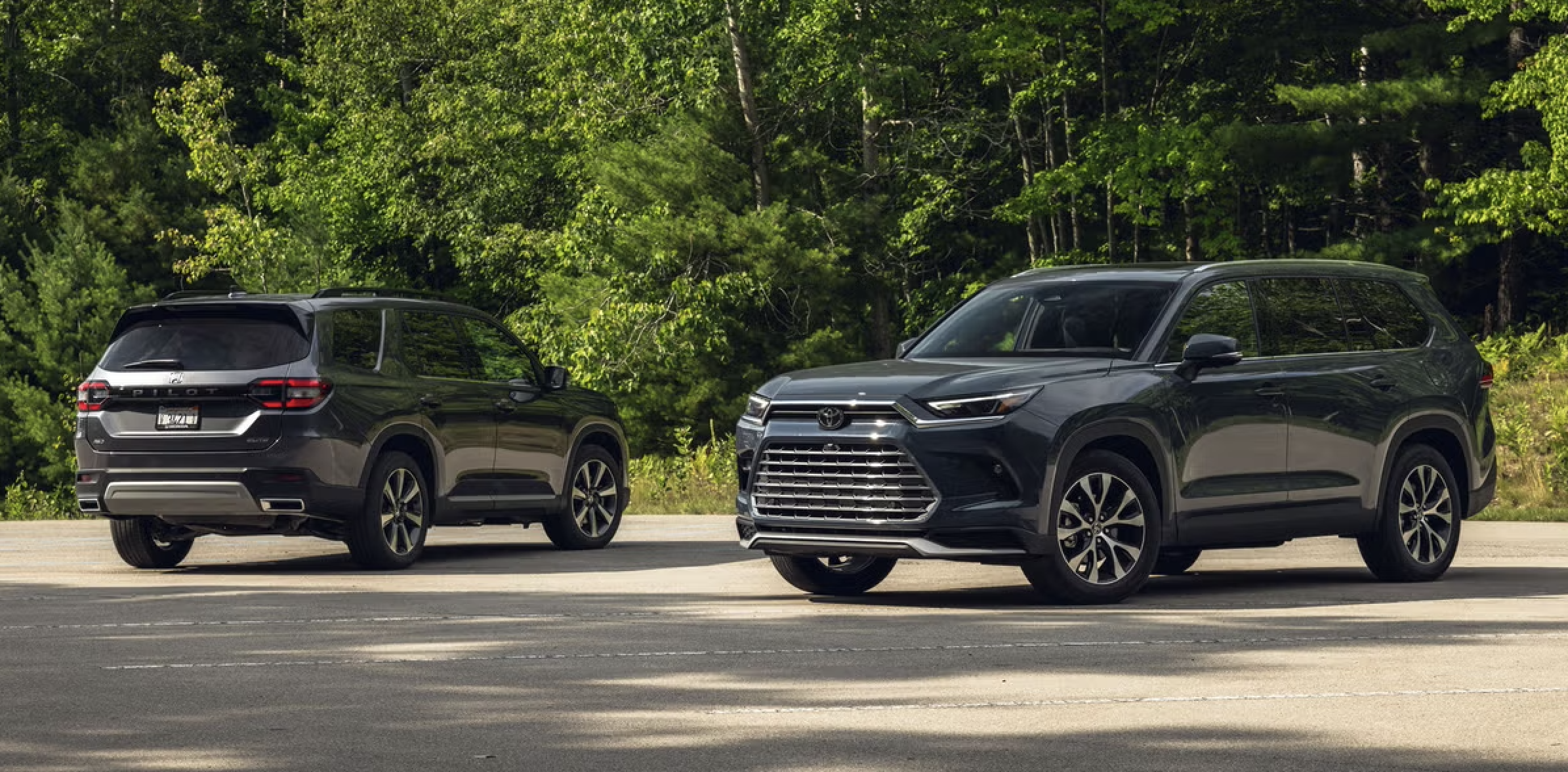Honda Pilot vs. Toyota Highlander vs. Grand Highlander: The Ultimate Family SUV Comparison
Trying to decide between three of the most popular three-row SUVs for families?
The 2025 Honda Pilot, 2025 Toyota Highlander, and the 20245 Toyota Grand Highlander are all icons in the midsize SUV world, known for their reliability, space, and family-friendly features. But while they might seem similar on the surface, each brings its own strengths when it comes to car seat flexibility, third-row comfort, cargo space, and everyday usability.
If you’re new here, welcome! I’m Kelly, the Car Mom, and as a Child Passenger Safety Tech (CPST), mom of four, and overall car lover, my goal is to help you find the best car for your family. In this post, I’ll break down how the 2025 Honda Pilot, Toyota Highlander, and Toyota Grand Highlander stack up across the categories that matter most to families.
Both the Pilot and Highlanders are fantastic choices-so you truly can’t go wrong. But there are a few key differences that could make one the better fit for your family.
Before we dive in — the Honda Pilot is better compared to Toyota Grand Highlander (but many forget this!).
I talk about this IN-DEPTH right here.
There are two major differences between the Toyota Highlander, Grand Highlander, and Honda Pilot: size and hybrid availability. The Highlander is smaller than both the Grand Highlander and the Pilot—especially in the third row. The Grand Highlander offers significantly more legroom and cargo space, making it the better choice if you need a roomier interior.
As for powertrains, both Toyota models are available as hybrids, while the Honda Pilot does not offer a hybrid option.
Highlander: Compact within the midsize SUV category; easier to maneuver but tight on interior space. Third-row seating is best suited for occasional use by kids or smaller passengers.
Grand Highlander: Larger in nearly every dimension with better legroom in all three rows and vastly improved cargo capacity. Offers a much more comfortable third row for older kids or adults.
Why Do Families Choose Three-Row SUVs?
Moving to a three-row SUV is a big jump for a few reasons. Yes, you gain two to three extra seats, which is great for bigger families or frequent carpooling—but you often lose trunk space compared to a two-row SUV, especially if that third row is always in use. It’s an important trade-off to think about before making the switch.
For families with three or more kids, or those who regularly carpool, a true three-row SUV like the Pilot or Highlander offers a blend of comfort, versatility, and capability that’s hard to beat.
My Honest Thoughts On These Cars…
Both the Toyota Highlander, Grand Highlander and the Honda Pilot are solid options, but they’re built for different types of families. The Highlander is a beautiful SUV with great tech and an impressive hybrid option—but it’s definitely on the smaller side for a three-row. If you’ve got more than two kids in car seats or plan to use the third row often, it might feel tight pretty quickly.
The Honda Pilot just makes more sense for bigger families or anyone juggling car seats and cargo on a daily basis. It’s super roomy, has way easier third-row access, more car seat hardware, and just feels more functional for real life. If I had to pick between the two for everyday family use, I’d go with the Pilot. Plus, you can remove the center seat on the bench giving you the option for both captain’s chairs AND a bench!
If you want to explore a Toyota SUV that is more similar to the Pilot, consider the Grand Highlander.
Honda Pilot vs Toyota Highlander/Grand Highlander: What I’m Comparing
Pricing and value
Fuel economy
Safety and reliability
Car seat compatibility
Third-row access and comfort
Cargo space and family practicality
Pricing and Value
Base MSRP + What’s Included At Entry Level
Honda Pilot: Starts around $40,000 for the base LX trim. Standard features include Honda Sensing safety suite, an 8-inch touchscreen, Apple CarPlay/Android Auto, three-zone climate control, and seating for eight. Higher trims add leather, a panoramic roof, and a 12.3-inch touchscreen.
Toyota Highlander: Starts slightly higher at around $41,000 for the base L trim. The Highlander includes Toyota Safety Sense 3.0, an 8-inch touchscreen, wireless Apple CarPlay/Android Auto, and a power driver’s seat. Higher trims add a 12.3-inch touchscreen, premium audio, and more upscale materials.
Toyota Grand Highlander: Starts at $43,000 for the LE trim. It also includes Toyota Safety Sense 3.0, an 12.3-inch touchscreen on the base model, wireless Apple CarPlay/Android Auto, and a power driver’s seat.
Price-wise, these are all very similar with only about a $3,000 difference between them. With pricing this close, it really shouldn’t be the deciding factor. Instead, focus on which features or layout work best for your family’s needs.
Warranty and Roadside Assistance
All three SUVs offer a 3-year/36,000-mile basic warranty and a 5-year/60,000-mile powertrain warranty. Toyota includes two years of complimentary maintenance, while Honda offers one year.
Both brands are known for reliability and strong resale value.
Let’s Talk Fuel Economy
Honda Pilot: Powered by a 3.5L V6 (285 hp, 262 lb-ft), the Pilot gets up to 19 mpg city and 27 mpg highway. All-wheel drive is available on all trims. A new hybrid version is expected, pairing a 2.0L turbo-four with electric motors for even better efficiency.
Toyota Highlander: Comes standard with a 2.4L turbo-four (265 hp, 310 lb-ft), returning up to 22 mpg city and 29 mpg highway (FWD). The Highlander Hybrid (2.5L four-cylinder + electric motors) is available on XLE and above, delivering up to 36 mpg combined-making it the clear choice for fuel-conscious families.
Toyota Grand Highlander: The Grand Highlander Comes standard 2.4L 4-Cyl. Turbocharged Engine Front-Wheel Drive. It also has an AWD option on the base trim. It achieves 21/28/24 on the LE and 36/32/34 on the hybrid version.
Both SUVs offer enough power for highway merging and family road trips, but the Highlander Hybrid’s efficiency is a major advantage if you want to save at the pump.
Safety and Reliability
Honda Pilot: Comes standard with the Honda Sensing suite, including adaptive cruise control, lane keeping assist, collision mitigation braking, and traffic sign recognition. Blind-spot monitoring and rear cross-traffic alert are available on higher trims. Previous Pilots have scored well with IIHS and NHTSA; 2025 ratings are pending but expected to be strong.
Toyota Highlander: Features Toyota Safety Sense 3.0, with pre-collision braking, adaptive cruise, lane tracing assist, and road sign assist. The Highlander is an IIHS Top Safety Pick+ and has a five-star NHTSA rating. Higher trims add blind-spot monitoring, rear cross-traffic alert, and parking assist.
Toyota Grand Highlander: It also Toyota Safety Sense 3.0, with pre-collision braking, adaptive cruise, lane tracing assist, and road sign assist. The Grand Highlander is NOT IIHS Top Safety Pick. The base trim has blind-spot monitoring rear cross-traffic alert- but parking assist is only on the higher trims.
Car Seat Compatibility - The Pilot Wins Here!





Honda Pilot: The second-row bench offers three full sets of LATCH anchors, making it one of the few midsize SUVs that truly supports “three-across” car seats. Even the captain’s chairs option includes LATCH anchors, adding flexibility for families who prefer that setup. And remember, the center seat on the bench is REMOVABLE!
Toyota Highlander: The second-row bench has two sets of LATCH anchors. Captain’s chairs do not have LATCH anchors, so you lose some flexibility for car seat installation.
Toyota Grand Highlander: The Grand Highlander offers three full sets of LATCH anchors total - but only 2 in the second row. It does have three tether anchors across the bench, meaning that you could have a forward-facing convertible seat or a booster seat in this spot to still achieve three across. The third row has one set of LATCH anchors, one tether, and one seat without any car seat hardware. This would only be suitable for a compatible booster seat.
Honda Pilot’s Party Trick - Removable Center Seat!
One of my favorite features in the Honda Pilot is the removable second-row center seat. You can pop it out in seconds and store it right under the trunk floor—no need to leave it in your garage. It gives you the flexibility to switch between a bench and captain’s chairs, which is so helpful as your family’s needs change.
Ease Of Installing Car Seats In Both Rows
Based on the car seat setup, the Honda Pilot has the edge with more flexibility—it offers seating for eight and generally better access to the third row. The Toyota Highlander, while comfortable for two kids in car seats, has limited anchor placements and tight third-row space, making it less ideal for families with three or more kids.
Let’s Compare 3rd Row Access
Honda Pilot: It’s very simple thanks to a low, kid-friendly tilt-and-slide button on the second-row bench. If you remove the middle seat, you get an easy pass-through—especially helpful when car seats are installed on both sides.
Toyota Highlander: Third-row access in the Highlander isn’t great. You can slide the second-row seat forward, but there’s no car seat tilt feature, and the climb-through space is super tight—especially with that fixed cup holder in the way. If you’ve got car seats installed, just know it’s not the easiest setup to work with.
Toyota Grand Highlander: The second-row seats have a button that lets you tilt and slide forward, opening up a wide path to the back. Just keep in mind—if you’ve got a car seat installed with LATCH, that seat won’t move, so third-row access can be trickier.
Third-Row Space
Honda Pilot: The third row in the Honda Pilot is actually pretty impressive. There’s good legroom, headroom, and features like vents and USB-Cs on both sides. Just don’t count on that middle seat—it’s tiny and not super usable.
Toyota Highlander: The third row in the Highlander Hybrid? It’s tight. The raised floor makes your knees hit your chest, and there’s barely any legroom—especially if there’s a car seat in front. It’s fine for quick trips, but definitely not an everyday third row. And with only one tether anchor back there, it’s not ideal for families with more than two kids in car seats.
Toyota Grand Highlander: The third row in the Grand Highlander is a huge improvement over the regular Highlander. There’s actually enough legroom and headroom to make it usable for older kids—or even adults on shorter drives. Kelly loves that it has vents, USB-C ports, and some of the best cup holders she’s seen. It’s not quite as roomy as something like the Traverse, but it’s way more functional than the original Highlander.
Which Has Better Trunk Space?
Honda Pilot: The Pilot’s trunk is super functional—even with the third row up. I love that the removable middle seat stores right in the trunk, and there’s still plenty of room for gear. It’s not the biggest out there, but it’s smartly designed and works well for families.
Toyota Highlander: Trunk space in the Highlander Hybrid is just okay. I squeezed in a double stroller, but it was definitely a push-and-run situation. You’ll likely have the third row folded most of the time to make the space more usable for everyday needs.
Toyota Grand Highlander: The trunk in the Grand Highlander is one of the biggest wins. It’s wide, deep, and easily fit my UPPAbaby Vista stroller with room to spare. The seats fold flat, and while underfloor storage is limited, this cargo space is a huge upgrade from the regular Highlander.
Honda Pilot vs Toyota Highlander vs Toyota Grand Highlander: Which Family SUV Is Right For You?
Choose The Honda Pilot If:
You need maximum passenger and cargo space, or often install three car seats in the second row.
You want the easiest third-row access for kids and car seats—even with LATCH-installed seats.
You prefer a more powerful V6 engine and extra towing capability.
You value user-friendly tech and family-focused features like a removable second-row seat or built-in vacuum.
You want a third row that’s actually usable for older kids or adults—not just for emergencies.
Choose The Toyota Highlander If:
You want the best fuel economy, especially with the Hybrid model averaging around 35 MPG.
You prefer a slightly more upscale interior and a quieter, smoother ride.
You value advanced safety features and Toyota’s strong reputation for long-term reliability.
You want a premium tech experience with a large touchscreen and wireless smartphone integration.
You only need space for two kids in car seats and don’t rely heavily on third-row seating—this one’s better suited for smaller families.
Choose The Toyota Grand Highlander If:
You want more space than the standard Highlander without jumping to a full-size SUV.
You need a usable third row with solid legroom, headroom, and features like USB-Cs and vents for older kids.
You value extra cargo space for strollers, sports gear, or road trips—this trunk is one of the best in its class.
You want hybrid efficiency option without sacrificing power—especially with the Hybrid MAX option.You’re looking for a well-balanced SUV that feels big enough for a growing family but still easy to drive and park.
The Bottom Line
The 2025 Honda Pilot, Toyota Highlander, and Toyota Grand Highlander are all solid picks for families, and each one brings something different to the table. The Pilot is great if you need lots of space, flexible car seat setups, and thoughtful features like a removable center seat. The Highlander is perfect for smaller families who want great fuel economy and a quieter, more refined ride. And the Grand Highlander? It gives you the extra room the regular Highlander’s missing—more trunk space, more third-row comfort—without going full-size.
At the end of the day, it really comes down to what matters most to your family. Whether it’s space, efficiency, or everyday ease, you’ve got three great options worth test driving.
Which midsize SUV would you choose? Let me know in the comments! And to keep up with all the latest family car reviews and tips, check out my recent posts:






